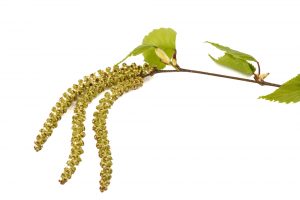Those yellow-bellied dusty devils are at it again. They’ve launched their annual full-scale attack, and no amount of antihistamines can stop them.
If you’re whipping tissues out of the box faster than a Wild West gunslinger, you’re not alone. My whole family has been doing it for weeks. All of us, even the dogs, have to line up for a daily Zyrtec. We do regular snorts of allergy nasal spray. And it’s all because of the catkins.
Let me formally introduce you to a meddling little menace you’ve probably seen for years but never knew its name. Catkins are those fuzzy, yellowish-brown strings that fall from trees each spring, usually in April. At first glance, you might mistake a catkin for a caterpillar or a worm because they’re similar in length. 
But that’s where the similarities end. Caterpillars are cute. Worms are harmless. But catkins are trying to kill me, one allergy attack at a time. This is biological warfare, plain and simple.
If you’ve ever been close to an oak tree — and that’s pretty much all of us except for people in Alaska — you’ve seen catkins. Our yard has lots of live oaks, and catkins are the male flowers that grow on oak trees and eventually get pushed out of the way by new leaves emerging each spring. (Female oak tree flowers turn into acorns.) When the wind blows, the catkins shimmy and shake before releasing what feels like a zillion tons of yellow pollen particles.
You’ve seen these bright yellow pollen particles coating the hoods of cars, right? You’ve probably felt them flying up your nose whenever you take out the trash. The catkins are the culprits putting the pollen there.
Once the catkins release pollen, they cascade down from the trees like invading paratroopers. Catkin corpses accumulate on grass, roofs, sidewalks, decks, and wherever the wind blows. In the cul-de-sac outside our house, they’ve drifted into brown mounds that look like seaweed.
The catkin strings often attach to the dog’s hair to hitch a ride inside. They use my car’s floorboards like their own personal Uber service. And they cling to the welcome mat even after I take a brisk broom to their backsides.
Technically speaking, catkins are “flowers,” but they don’t look like it. In terms of visual appeal, I’d say dryer lint is sexier than a wad of catkins. But maybe I shouldn’t shame them this way. They’re just playing their part to help trees get their groove on and make baby trees. I get it. I mostly paid attention to that part of science class.
Don’t get me wrong. I’m pro-pollination. Pro-birds. Pro-bees. Pro flowers and trees. It’s nature doing what nature does. But it does come with side effects. For weeks, my family and millions of others have been itching, sneezing, blowing noses, and popping antihistamines like they’re TicTacs. We need a break (and another box of tissues, please).
The good news is that hope is on the horizon. Soon, spring will have fully sprung, which means the catkins’ reign of terror will end. By mid-May, the trees smoke a post-catkin cigarette and get on with the business of growing leaves and shading the yard for summer.
Then we’ll have about 10 months of a catkin-free existence, long enough to almost forget about them. But then, one day next April, the first catkin of the year will drift down on a subtle spring breeze and land oh-so-gently on my head — an undetectable attack I won’t even notice until someone picks it out of my hair and shows me the fuzzy evidence.
When I lay eyes on that nasty nemesis, I’ll reach for a tissue because I’ll feel a sneeze coming on. And then he’ll look at me in that smug way that only cocky catkins do, and I’ll know exactly what he’s saying: “We’re baaa-ack!”
Gwen Rockwood is a syndicated freelance columnist. Email her at gwenrockwood5@gmail.com. Her book is available on Amazon.
